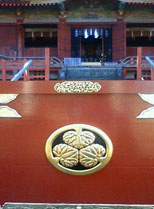Tokugawa Tour
 Ojima in Ota City was the main area of the Nitta Manor in the Medieval Period. In the Edo Era, the area prospered with the support of the Tokugawa Edo government because Yoshisue Tokugawa, the founder of the Tokugawa clan, was believed to have been from this area. Many historical sites are located within the city.
Ojima in Ota City was the main area of the Nitta Manor in the Medieval Period. In the Edo Era, the area prospered with the support of the Tokugawa Edo government because Yoshisue Tokugawa, the founder of the Tokugawa clan, was believed to have been from this area. Many historical sites are located within the city.
Ojima is also known to have held a piece of land belonging to Tsugaru, Aomori Prefecture, and so in cooperation with Hirosaki City, Aomori, a festival called Ojima Neputa Matsuri is held on August 14th and 15th of every year.
General Tour
Where to Go for Sightseeing
Yasaka Jinja (Yasaka Shrine)A big festival called Serada Gion is held at the end of July. Address: 1497 Serada-cho, Ota |
The History ParkMany historical sites surround the park, including Tosho-ji (Tosho Shrine), Choraku-ji (Choraku Temple) and Nitta-no-sho Museum of History. |
Fumon-ji (Fumon Temple)This is a Tendai Sect temple. In the precincts, there is a Buddhist temple bell donated by the Iwamatsus. There is also the tomb of Konzo Moro, a historian, who wrote a history of Gunma Prefecture. Address: 1128 Serada-cho, Ota |
Eitoku-ji (Eitoku Temple)This temple is also called Satsuki-dera (Azalea Temple) because of its beautiful azalea garden. It is believed that Yoshisue Tokugawa lived in this area. Address: 373 Tokugawa-cho, Ota |
Enkiri-dera Mantoku-ji Shiryo-kan
|
Toyo-ji (Toyo Temple)Parcels of land surrounding Ootachi town in Ota were previously administered by Tsugaru, Aomori. Thus, a stone pagoda of Adachi, a local administrator of Tsugaru, stands in the precincts of Toyo-ji (Toyo Temple) Address: 1492 Ootachi-cho, Ota |
Myouou-in (Myouou Temple)A must to see is a 6-meter-high stone pagoda shaped like a pyramid with a thousand Fudo Myouou carved on the four sides and a tower on the top inscribed in Sanskrit characters. Address: 200-1 Anyoji-cho, Ota |
Jozo-ji (Jozo Temple)Gochi-do Fudo-do is located within the precincts of this temple. The ginkgo tree behind it is the largest of its kind in Gunma Prefecture. Address: 221 Horiguchi-cho, Ota |
Iwamatsu Hachiman-gu
|
Shoren-ji (Shoren Temple)It is believed that this temple was constructed by Yoshikuni Minamoto. One of his descendents, Hisazumi Iwamatsu had his secluded life in this temple. He enjoyed writing poems, drawing and painting. His self-portrait left in the temple was registered a important prefectural cultural property. Address: 609 Iwamatsu-cho, Ota. |
Aimin-ji (Aimin Temple)This is a temple belonging to the Jodo Sect. Gyokunen was the first priest here. Address: 454-1 Ojima-cho, Ota |
 Yabuzuka Onsen (Yabuzuka Hot Spring)
Yabuzuka Onsen (Yabuzuka Hot Spring) Nitta-no-sho National Historical Site
Nitta-no-sho National Historical Site Recommended Tours of Sightseeing
Recommended Tours of Sightseeing


